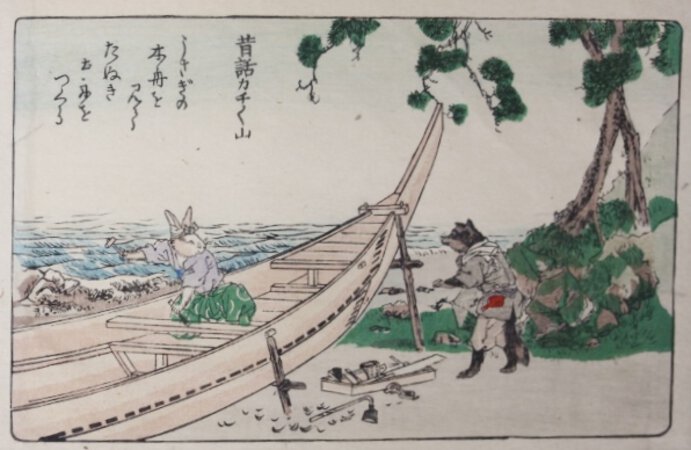Kachi-kachi Yama: The Rabbit vs Tanuki, A Tale of Murder and Torture
The Immortal Legend of the Rabbit
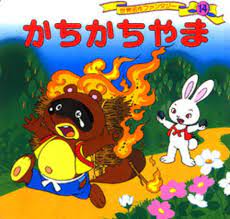
One such story that has withstood the test of time is the legend of Kachi-kachi Yama. This medieval tale, set in a picturesque Japanese landscape, is full of drama and emotion, with its characters becoming symbols of deeper truths. Interestingly, unlike many other legends, Kachi-kachi Yama is rarely presented as a moral tale or a simple story of revenge. Instead, it showcases the complexity of human emotions and the consequences of their actions. This depth and universality have allowed the legend not only to survive through the ages but also to find new life in contemporary media, such as anime and video games, testifying to its enduring appeal and significance in Japanese culture.
Premiere of Kachi-kachi Yama
 Origins of the Legend
Origins of the Legend
The legend of Kachi-kachi Yama is one of the most well-known and cherished stories in Japanese folklore, rooted in medieval times. The earliest mentions of this story can be found in various forms of folk art, such as traditional Japanese theatrical performances and orally passed-down tales. However, the first recorded versions of this story appeared much later, during the Edo period (1603-1868), when Japanese literature and art began to flourish. These records were often created as moral tales or entertainment, intended to convey important life lessons and preserve traditional beliefs and stories for future generations.
Spread in Culture
Over time, the legend of Kachi-kachi Yama gained popularity, becoming an integral part of Japanese culture. During the Meiji period (1868-1912), when Japan opened up to Western influences, many traditional legends were written down and published in book form, further contributing to the spread of this story across the country. Publishing these stories in print helped solidify and standardize the various versions of the legend that had previously existed mainly in oral form.
What Does the Title Mean?
The title of the legend, 'Kachi-kachi Yama' (カチカチ山), is an onomatopoeia that plays a key role in the story. 'Kachi-kachi' imitates the sound of crackling fire or rapid rubbing, which is a direct reference to one of the central motifs in the story. 'Yama' means 'mountain' in Japanese, indicating the setting where the legend unfolds. Thus, the title is not just a name but also contains auditory and visual elements that reflect the character and atmosphere of the story. This combination of onomatopoeia with a natural landscape element is characteristic of Japanese culture and language, emphasizing the link between the story and its environment.
The Story of Kach-kachi Yama
 Beginning
Beginning
The legend of Kachi-kachi Yama unfolds in a bucolic, mountainous landscape of Japan. The main characters are an old, kind-hearted man, his wife, and a cunning and malicious tanuki, also known as a Japanese raccoon dog. The elderly couple lived peacefully, taking care of their home and garden, but their life was disrupted by the constant pranks and thefts of the tanuki.
The tanuki was a notorious prankster, regularly stealing food from the old man's field, causing much trouble for the couple. His tricks and pranks were not only bothersome but also potentially life-threatening.
Desperate, the old man decided to catch the tanuki. He managed to do so using a trap, which brought him a sense of relief but also concern for the creature's fate. He decided that the tanuki would be turned into soup, which was meant to be the punishment for his pranks.
A Cruel Twist
During the old man's absence, the tanuki, using its magical abilities, freed itself and in an act of vengeance, killed the old man's wife. Then, it assumed her appearance to deceive the old man.
When the old man returned home, unaware of the deception, the tanuki, posing as his wife, served him soup which, in reality, had been made from his true wife's body. After the meal, the tanuki revealed its true identity and the cruel truth about the soup, deeply wounding the old man.
 Revenge
Revenge
Distraught and seeking vengeance, the old man decided to form an alliance with a rabbit, who was also fed up with the tanuki's pranks. The rabbit, being clever and agile, devised a plan for revenge.
The next day, the Rabbit found itself in the company of the Tanuki, inviting it to join in mowing the grass. The Tanuki, thinking the Rabbit was its friend, suspected nothing. After they finished their work and loaded their backs with cut grass, the Rabbit set the grass on Tanuki's back on fire.
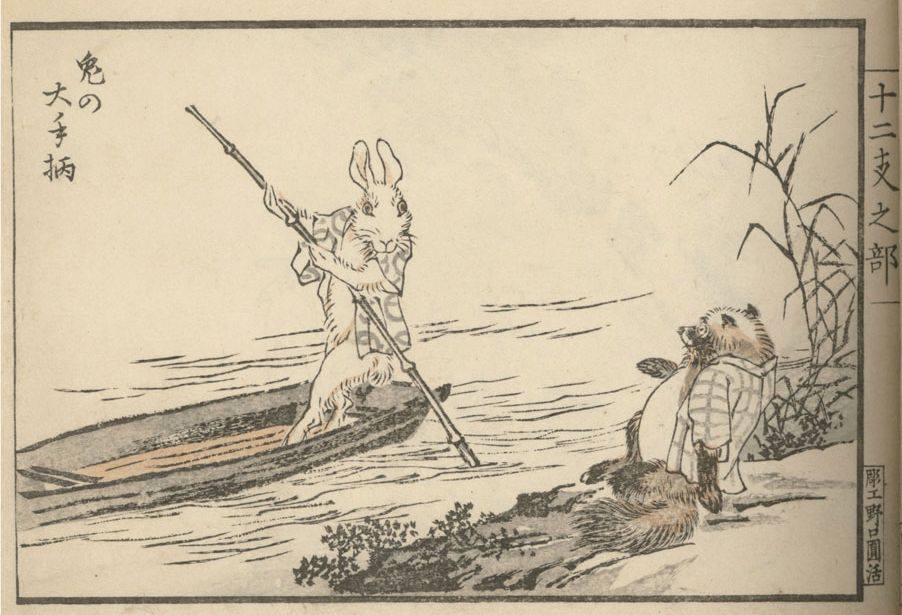
Then, the Rabbit suggested they go fishing together. It built two boats: a wooden one for itself and a clay one for the Tanuki. On the water, it proposed a race. Tanuki's clay boat started to disintegrate, and when it asked the Rabbit for help, the Rabbit refused, confessing it wanted to avenge the old woman's death. The Rabbit hit Tanuki with an oar, leading to the sinking of its boat.
The Rabbit returned to the old farmer with news that it had made Tanuki's life unbearable and full of suffering and finally killed it. And from then on, they lived long and happily.
The Moral of the Fable and Murder and Torture (Rabbit vs Tanuki)
On the first level of interpretation, this story illustrates the classic conflict between justice and revenge. The Rabbit, initially a sympathetic figure and on the side of the wronged, undergoes a transformation into an executioner. In fact, a similar escalation is already seen earlier – the old man wants to punish the tanuki for its "pranks" by cooking it alive (soup).
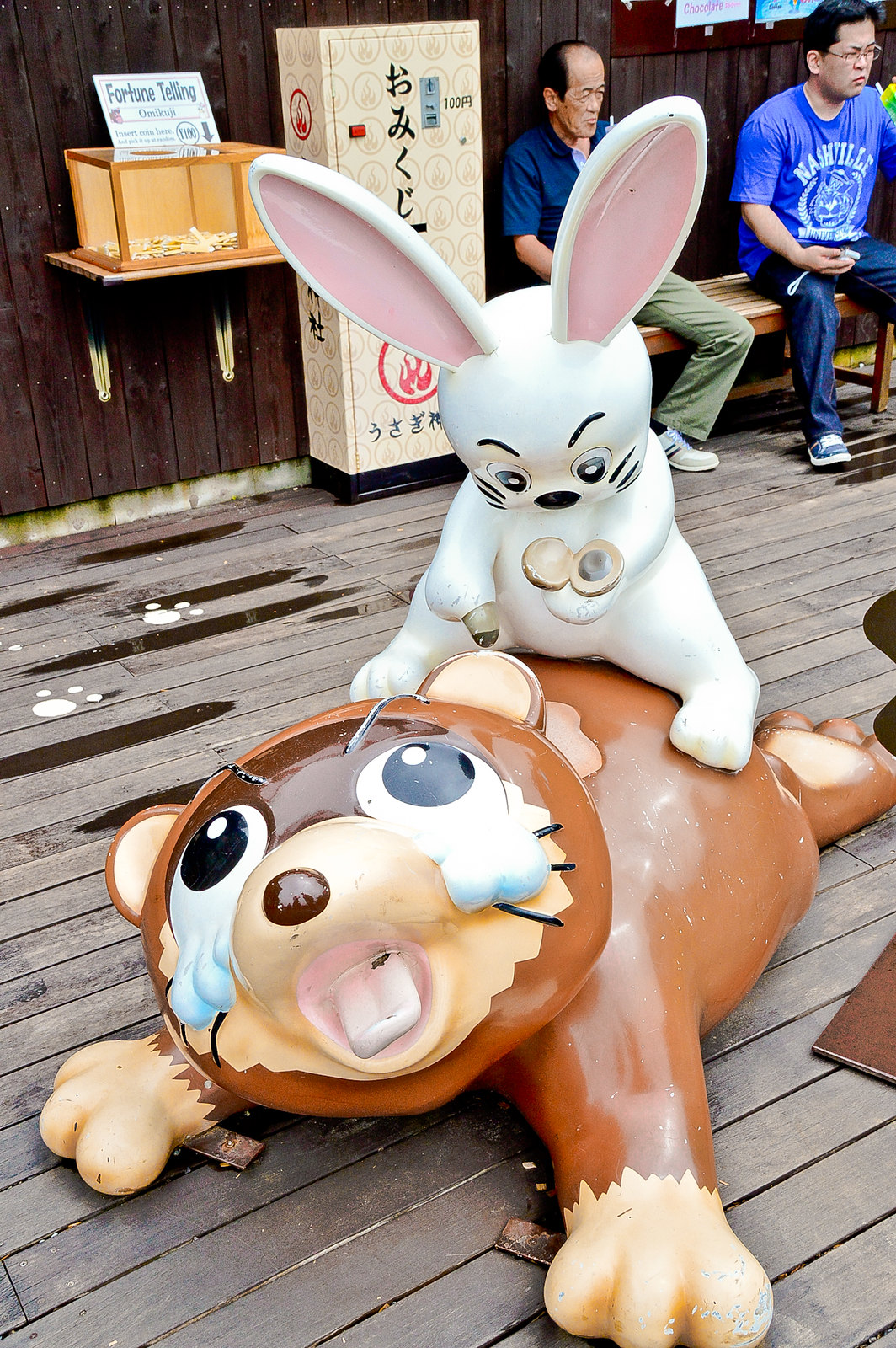
Kachi-kachi Yama raises questions about the morality of the Rabbit's actions. Are its brutal methods justified by Tanuki's earlier evil? What principles should be followed when regulating the limits within which the force of retribution is still acceptable, and beyond which it is not? Is the very concept of retribution inherently linked to an escalation of increasingly "severe punishments"?
Finally, the story can be interpreted as a reflection of the internal conflicts of human nature: between the desire for revenge and the longing for forgiveness, between brutality and compassion. In this context, the story of "Kachi-kachi Yama" becomes a metaphor for human experience and the constant struggle between our dark and light sides.
Popularization of the Legend in Japan
Kachi-kachi Yama, being one of the most recognizable legends in Japan, has had a significant impact on various aspects of Japanese culture. Its popularity is not limited to literature and folk tales; the legend has also found its place in theater and visual arts. For example, in traditional Japanese puppet theater Bunraku and Kabuki theater, Kachi-kachi Yama has been adapted and presented multiple times, demonstrating its deep-rootedness in cultural consciousness. Additionally, the tanuki, the central figure in the legend, has become a popular motif in Japanese ceramics and sculpture, often depicted as a playful, though sometimes malicious, symbol of luck and prosperity.
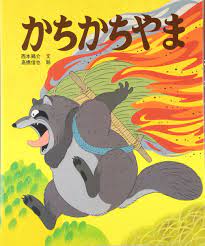
Adaptations of the Kachi-kachi Yama Legend
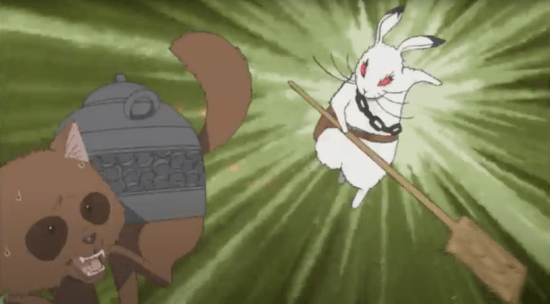
In the later part of the episode, the story concentrates on the old man's alliance with a clever rabbit and their joint plan for revenge on the tanuki. The rabbit, using wit and cunning, metes out justice to the tanuki through a series of reprehensible traps and deceits, ultimately leading to the tanuki's defeat. This episode, with its detailed and faithful adaptation, highlights the dark and brutal aspects of this traditional Japanese legend, while preserving its cultural significance and the moral about the consequences of evil deeds.
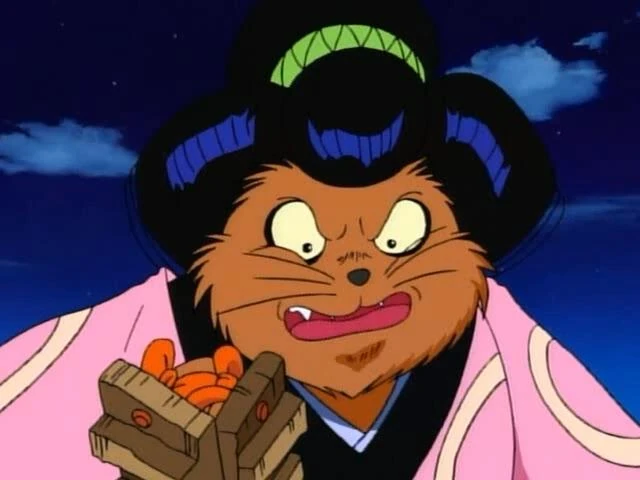
"Okami" - In the video game "Okami," inspiration from the Kachi-kachi Yama legend is evident in characters and themes based on Japanese mythology. The game utilizes elements of nature and spirituality, transforming them into an interactive storytelling form. Thus, "Okami" serves not only as entertainment but also as a medium to explore and experience Japanese culture and its legends.
"Kamisama Kiss" - The anime "Kamisama Kiss" subtly incorporates elements of the Kachi-kachi Yama legend through the character of the tanuki. In this series, themes of loyalty, honor, and transformation are key, showing how elements of legends can be adapted in the context of contemporary, romantic stories.
"Nura: Rise of the Yokai Clan" - "Nura: Rise of the Yokai Clan" weaves into its storyline characters based on the tanuki and other spirits from Japanese folklore, including the Kachi-kachi Yama legend. This series, blending traditional legends with elements of fantasy and combat, presents the battle between good and evil in a modern context, while maintaining the essence of the original story.
"Animal Crossing" - In the popular video game "Animal Crossing," the character Tom Nook is inspired by the tanuki from the Kachi-kachi Yama legend. In this adaptation, the tanuki is portrayed as a cunning businessman, which is a humorous nod to the prankster from the legend. This game demonstrates how folklore elements can be woven into everyday, virtual life.

"The Eccentric Family" - The manga "The Eccentric Family" focuses on a tanuki family, referencing the Kachi-kachi Yama legend. In this series, family themes and transformations are crucial, revealing deeper aspects of life and culture of the tanuki. Thus, this manga offers a more introspective and emotional perspective on the legend.
"Shin Megami Tensei" - In the "Shin Megami Tensei" game series, the tanuki from the Kachi-kachi Yama legend appears as one of the summonable characters. In this adaptation, the power and magic of the tanuki are utilized within the context of an RPG game, illustrating how legends can be transformed into gameplay elements.
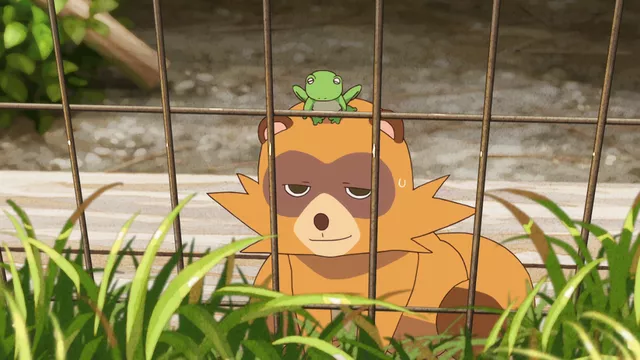
Kachi-kachi Yama - A Contemporary Reflection of an Ancient Legend
In summarizing our exploration of the Kachi-kachi Yama legend, it's noteworthy how this classic Japanese tale finds its reflection in modern culture. Despite its medieval origins, this story continues to appear in various media forms, from anime to video games. An interesting fact is that in some versions of this story, the character of the tanuki is not only a mischievous trickster but can also take the form of a protective spirit, guarding homes and bringing fortune, reflecting the complexity of the character in Japanese culture.
Another intriguing aspect is that despite its brutality, the story is often used as an educational tool, teaching about the consequences of actions and the importance of justice. This adaptability of the legend, allowing it to survive through the ages and changing cultures, demonstrates its lasting impact and significance. Kachi-kachi Yama, although it may seem like just an old tale, still holds its place in today's world, serving as a bridge connecting the past with the present.
>> SEE ALSO SIMILAR ARTICLES:
Tanuki Swinging His Coin Pouch – How Did Japanese Woodblock Artists See This Rascal?
Kappa - the Face of Japanese Folklore and the Star of All Yōkai
Yōkai Oddities: 10 Instances of Unbridled Imagination in Japanese Folklore
Shōjō – the yōkai who drank with style but knew nothing of tomorrow
"Strong Japanese Women"
see book by the author
of the page
未開 ソビエライ
An enthusiast of Asian culture with a deep appreciation for the diverse philosophies of the world. By education, a psychologist and philologist specializing in Korean studies. At heart, a programmer (primarily for Android) and a passionate technology enthusiast, as well as a practitioner of Zen and mono no aware. In moments of tranquility, adheres to a disciplined lifestyle, firmly believing that perseverance, continuous personal growth, and dedication to one's passions are the wisest paths in life. Author of the book "Strong Women of Japan" (>>see more)
Personal motto:
"The most powerful force in the universe is compound interest." - Albert Einstein (probably)
Mike Soray
(aka Michał Sobieraj)
未開 ソビエライ
An enthusiast of Asian culture with a deep appreciation for the diverse philosophies of the world. By education, a psychologist and philologist specializing in Korean studies. At heart, a programmer (primarily for Android) and a passionate technology enthusiast, as well as a practitioner of Zen and mono no aware. In moments of tranquility, adheres to a disciplined lifestyle, firmly believing that perseverance, continuous personal growth, and dedication to one's passions are the wisest paths in life. Author of the book "Strong Women of Japan" (>>see more)
Personal motto:
"The most powerful force in the universe is compound interest." - Albert Einstein (probably)
Mike Soray
(aka Michał Sobieraj)
Write us...
Ciechanów, Polska
dr.imyon@gmail.com
___________________
inari.smart
Would you like to share your thoughts or feedback about our website or app? Leave us a message, and we’ll get back to you quickly. We value your perspective!

 Origins of the Legend
Origins of the Legend Beginning
Beginning Revenge
Revenge
